
Oscar-Claude Monet was a French painter and founder of impressionism painting who is seen as a key precursor to modernism, especially in his attempts to paint nature as he perceived it. During his long career, he was the most consistent and prolific practitioner of impressionism's philosophy of expressing one's perceptions of nature, especially as applied to plein air (outdoor) landscape painting. The term "impressionism" is derived from the title of his painting Impression, soleil levant, which was first exhibited in the so-called "exhibition of rejects" of 1874–an exhibition initiated by Monet and like-minded artists as an alternative to the Salon.

Édouard Manet was a French modernist painter. He was one of the first 19th-century artists to paint modern life, as well as a pivotal figure in the transition from Realism to Impressionism.

Pierre-Auguste Renoir was a French artist who was a leading painter in the development of the Impressionist style. As a celebrator of beauty and especially feminine sensuality, it has been said that "Renoir is the final representative of a tradition which runs directly from Rubens to Watteau."
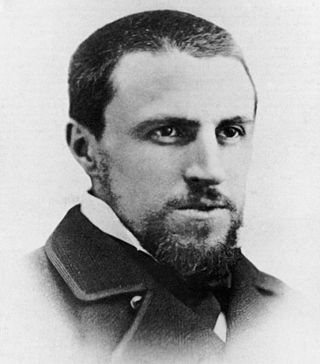
Gustave Caillebotte was a French painter who was a member and patron of the Impressionists, although he painted in a more realistic manner than many others in the group. Caillebotte was known for his early interest in photography as an art form.

Argenteuil is a commune in the northwestern suburbs of Paris, France. It is located 12.3 km (7.6 mi) from the center of Paris. Argenteuil is a sub-prefecture of the Val-d'Oise department, the seat of the arrondissement of Argenteuil. Argenteuil is part of the Métropole du Grand Paris.
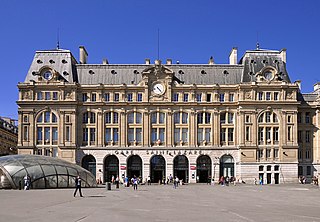
The Gare Saint-Lazare, officially Paris Saint Lazare, is one of the seven large mainline railway station terminals in Paris, France. It was the first train station built in Paris, opening in 1837. It mostly serves train services to western suburbs, as well as intercity services toward Normandy using the Paris–Le Havre railway. Saint-Lazare is the third busiest station in France, after the Gare du Nord and Gare de Lyon. It handles 290,000 passengers each day. The current station building opened in 1889 and was designed by architect Juste Lisch; the maître d'œuvre was Eugène Flachat.
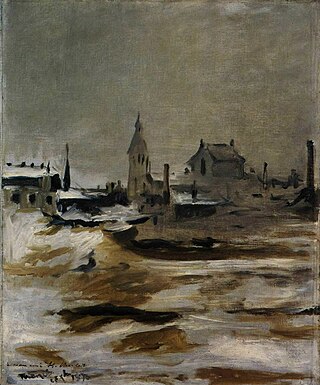
Effect of Snow on Petit-Montrouge is an 1870 landscape painting by the French painter Édouard Manet. The 61.6 cm x 50.4 cm oil on canvas composition depicts the 14th arrondissement's district, Petit-Montrouge, under a wintry landscape.

The Magpie is an oil-on-canvas landscape painting by the French Impressionist Claude Monet, created during the winter of 1868–1869 near the commune of Étretat in Normandy. Monet's patron, Louis Joachim Gaudibert, helped arrange a house in Étretat for Monet's girlfriend Camille Doncieux and their newborn son, allowing Monet to paint in relative comfort, surrounded by his family.

Bords de la Seine à Argenteuil is an oil painting by an unknown artist. The painting is a landscape depicting the River Seine at Argenteuil in France. It is owned by Englishman David Joel.

Springtime or The Reader is an 1872 painting by the French Impressionist painter Claude Monet. It depicts his first wife, Camille Doncieux, seated reading beneath a canopy of lilacs. The painting is presently held by the Walters Art Museum.
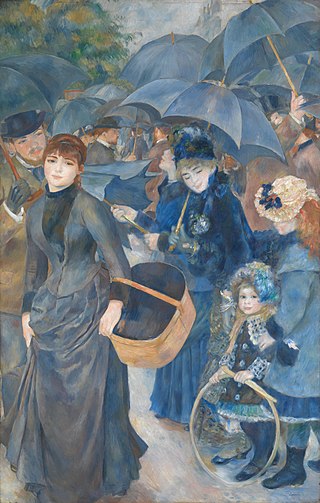
The Lane Bequest is a collection of 39 paintings from the estate of Sir Hugh Lane. The collection is mainly paintings by French 19th-century artists, including several by the Impressionists, including masterpieces such as Manet's Music in the Tuileries (1862) and Renoir's The Umbrellas (c.1881), along with many more modest works. The collection is owned by the National Gallery, London, but most of the paintings are now displayed at the Hugh Lane Gallery in Dublin.

Boating is an oil-on-canvas painting by French artist Édouard Manet. The painting depicts a man and woman on a sailboat during the summertime. It was painted during in the summer of 1874, during which time Manet was staying on his family's property in Gennevilliers. Art historians have suggested that the woman may be Camille Monet, while the man has often been identified as Manet's brother-in-law Rodolphe Leenhoff.

Argenteuil is an 1874 oil on canvas painting by Édouard Manet (1832-1883), first exhibited at the Paris Salon of 1875. It is one of Manet's first works to be regarded as a fully Impressionist painting due to its naturalistic style and its bold palette. The painting depicts a sailor and his companion sitting on a mooring dock surrounded by sailboats, the deep blue water of the Seine, and the town of Argenteuil on the far bank. Art historians have described Argenteuil as a response to Claude Monet's depiction of similar subject matter.
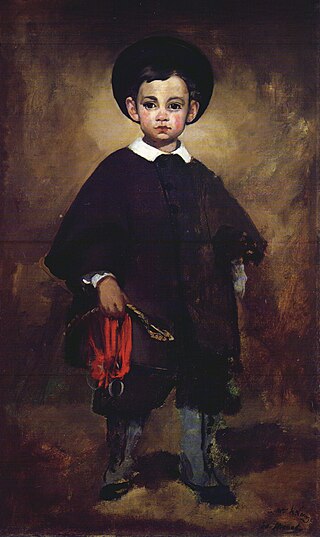
Little Lange is a c.1861 oil-on-canvas painting by Édouard Manet, now on the Staatliche Kunsthalle Karlsruhe. It shows a boy around five years old from the Lange family, who were friends of the artist. Its dark palette is reminiscent of Spanish Golden Age works as well as Antoine Watteau's Gilles (Louvre). Produced early in the painter's career, the work's execution is sketchy in places and prefigures his later Impressionist work.

A Young Lady in 1866 or Lady with a Parakeet is an 1866 painting by Édouard Manet, showing his favourite model Victorine Meurent, wearing a pink gown, holding a small bouquet of violettes and accompanied by an African Grey Parrot. It is an oil painting on canvas measuring 185.1 x 128.6 cm, and is now in the Metropolitan Museum of Art in New York. It and Boy Carrying a Sword were the first of Manet's works to enter a gallery collection.

Rue de la Chaussée in Argenteuil or A Square in Argenteuil is an 1872 painting by Alfred Sisley, now in the Musée d'Orsay, where it has hung since 1986. It was left to the French state in 1906 by Étienne Moreau-Nélaton, who had bought it earlier that year from François Depeaux's collection via the art dealer Georges Petit.

A Cart on the Snowy Road at Honfleur is an oil-on-canvas snowscape painting by French impressionist Claude Monet. The painting depicts a man on a wooden cart travelling along a snow-laden road in Honfleur.
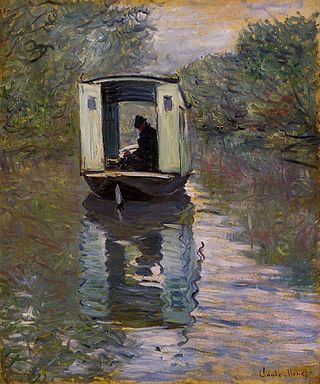
The Studio Boat is a painting from 1876 by the French Impressionist Claude Monet. The work depicts Monet at work in his studio boat on the Seine in Argentueil. It was executed en plein air in oil on canvas. It currently is in the collection of the Barnes Foundation of Philadelphia.

The Batignolles group was a group of young avant-garde painters from the end of the 19th century who gathered around Édouard Manet. The group bears its name in reference to the Batignolles district, where the artists used to meet between 1869 and 1875. Many of the artists in the group later became known for the Impressionism movement.

The Train in the Snow, or Le train dans la neige, is a landscape painting by the French Impressionist artist Claude Monet. The work depicts a train surrounded by snow at the Argenteuil station in France. Art historians see the work as a significant example of Monet's efforts to integrate nature and industry in his work. Many historians believe that Monet, out of all of the notable nineteenth century artists, made the most paintings of trains in his lifetime.




















